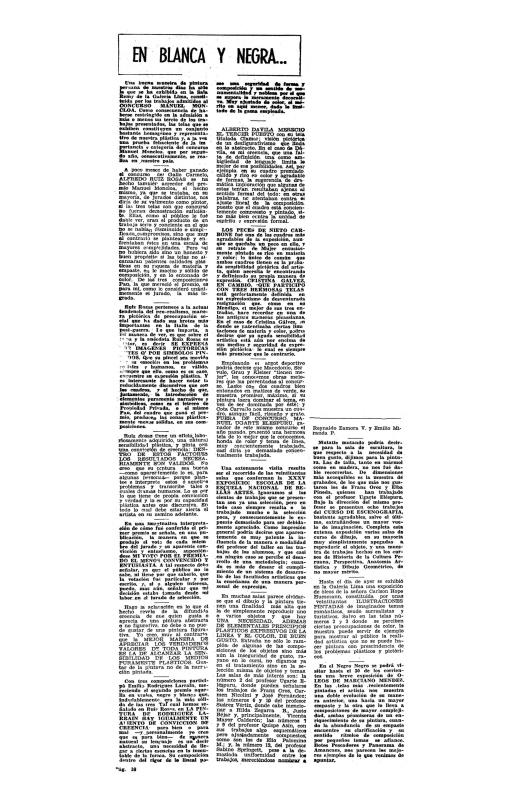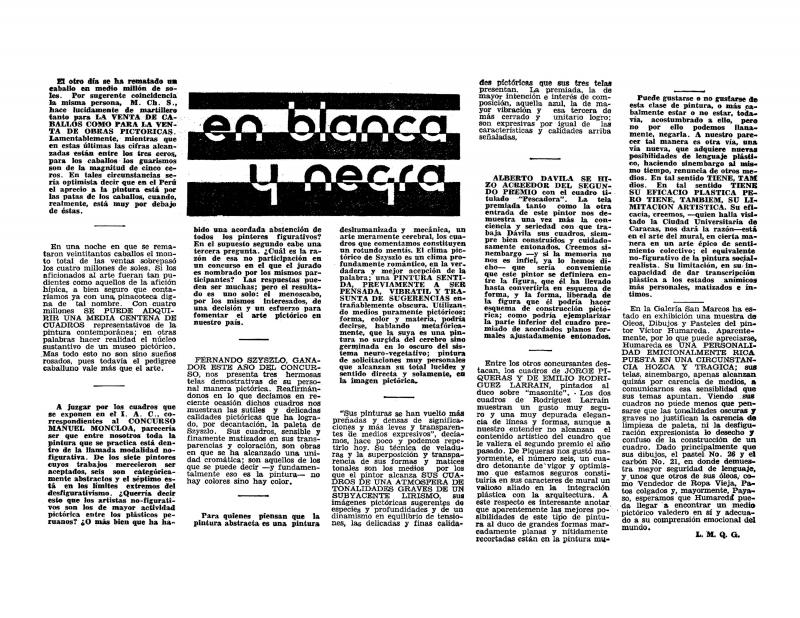In this open letter, Alejandro Romualdo Valle responds to the critical comments of the Modernist architect Luis Miró Quesada Garland (El Comercio, Lima, January 30, 1955). The subject here is Romualdo’s hypothesis of an “integral art” proposed in one of his earlier articles (published on January 9, 1955).
In January 1955, the canvas Pan by Alfredo Ruiz Rosas (1926–2002) won the first prize at the Second Salón de Pintura Manuel Moncloa (Lima). [In the ICAA digital archive, see the article by Manuel Jesús Orbegozo, “Un “pan” común de todos los días, amasado por Alfredo Ruiz Rosas, ganó diez mil soles” (doc. No. 859785)]. Awarding the prize to the main representative of social realism in Peru had major repercussions in an art milieu polarized by the debate about Abstract art. Those who opposed nonfigurative art saw a model for contemporary painting in his work, even though it was tied to “reality” and to the general viewing public. For the journalist inspired by Marxism, Alejandro Romualdo Valle (1926–2008), Ruiz’s painting represented “integral art,” combining visual-art experimentation with human commitment. Thus, the winning artwork was a far cry from abstract, aestheticist “specialization” [see “Ruiz Rosas y un arte integral,” by Alejandro Romualdo (doc. No. 1227027)]. This reading led to an extended debate with the Modernist art critic and architect Luis Miró Quesada Garland (1914–94), who—as a member of the jury at the Second Salón Moncloa—supported the prize winner for strictly artistic reasons [“En blanca y negra...” (January 16, 1955), by Garland (doc. No. 859805)]. The resulting debate revealed the intensity of the intellectual and political tensions unleashed by the eruption of nonfigurative art in Peru [see the following articles: by Garland, “En blanca y negra...” (doc. No. 859826">859826), “Sobre un arte integral” (doc. No. 1227195); and by Alejandro Romualdo, “Sobre un arte integral: punto final” (doc. No. 1227176)]. This exchange of opposing opinions can be compared with a debate about a year later when the first prize at the third round of the same competition was awarded to an abstract work by Fernando de Szyszlo (b. 1925) [see the articles: by Sebastián Salazar Bondy, “Artes Plásticas” (doc. No. 859662); by Garland, “En blanca y negra” (doc. No. 859754), and “En blanca y negra…” (doc. No. 1137283); and one more in his regular column “En blanca y negra…” (January 30, 1955) (doc. no. 859826">859826); by Szyszlo, “Cartas al Director” (doc. No. 1227064); by Alejandro Romualdo, “Cuidado con la pintura: el arte por el arte abstracto —comentario al premio ‘Manuel Moncloa y Ordóñez’” (doc. No. 1227101); by Manuel Jesús Orbegozo, “Entrevista concreta a un pintor abstracto” (doc. No. 1227120); “La pintura abstracta: proceso de subjetivación —Szyszlo trata de explicar lo que pocos entienden” (unsigned) (doc. No. 1227046); and by Juan Manuel Ugarte Eléspuru, “12 meses de artes plásticas en Lima” (doc. No. 1137301)].














